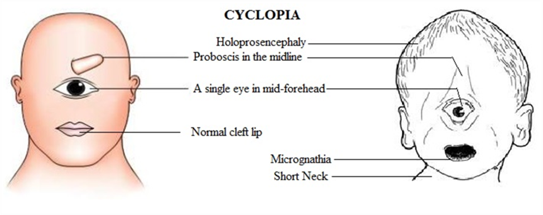Abstract
Holoprosencephaly has a sever condition called Cylopia that is occur due to embryonic prosencephalon cleavage failure and contrast. Mostly cylopia form is holoprosencephaly, mid facial tissue is absent which causes the one eye on a single orbit. It is a sever deformity of median faciocerebal development. There are 1.05 cases in 100,000 birth, still births of cyclopean. Abnormal nose above eyes or absence of nose, single eyes or half divided eyes in single orbit are features of cyclopia, where as reduced size of oral aperture or absence of mouth, absence of mandible with ears below chin. It is as etiologically heterogeneous condition, which can be caused by genetic mutation, chromosomal defect and teratogenic environmental factors. Environmental factors can be diabetic embryopathy, retinoic acid, several anecdotal suggestion of teratogenic factor for HPE, which includes salicylates and viruses. Some list of syndrome are also involved to cause cyclopia Like steinfeld syndrome, dysgnathia complex,Pseudotrisomy 13 syndrome and Smith–Lemli– Opitz syndrome. On other hand inborn abnormalities also cause cyclopia but its come under chromosomal syndrome. Anatomical detection can be done by brain MRI, whereas in prenetal diagnosis, sonography is more significant. Ultrasound also used early detection can be done and knowledge of sonographic finding soectrum leads to accuracy of prenatal diagnosis of cyclopia. After birth the chromosomal study helps to diagnose cyclopia along with postmortem biopsy.
Full text article
Authors

This work is licensed under a Creative Commons Attribution-NonCommercial-NoDerivatives 4.0 International License.

